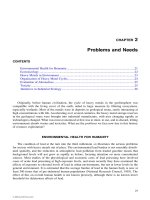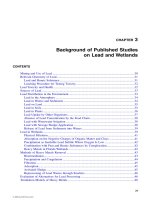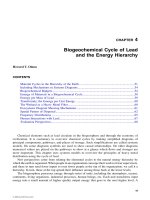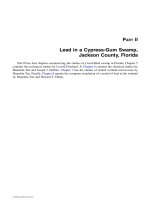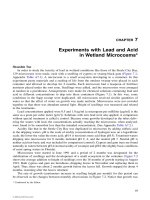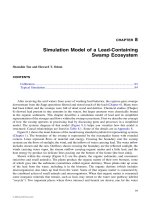Heavy Metals in the Environment: Using Wetlands for Their Removal - Chapter 1 doc
Bạn đang xem bản rút gọn của tài liệu. Xem và tải ngay bản đầy đủ của tài liệu tại đây (1.7 MB, 27 trang )
Heavy Metals
in the
Environment
Using Wetlands
for Their Removal
© 2000 by CRC Press LLC
LEWIS PUBLISHERS
Boca Raton London New York Washington, D.C.
Howard T. Odum
Wlodzimierz Wójcik
Lowell Pritchard, Jr.
Shanshin Ton
Joseph J. Delfino
Malgorzata Wójcik
Slawomir Leszczynski
Jay D. Patel
Steven J. Doherty
Jacek Stasik
Center for Environmental Policy and
Center for Wetlands
Environmental Engineering Sciences
University of Florida
Gainesville, Florida
Heavy Metals
in the
Environment
Using Wetlands
for Their Removal
© 2000 by CRC Press LLC
This book contains information obtained from authentic and highly regarded sources. Reprinted material is
quoted with permission, and sources are indicated. A wide variety of references are listed. Reasonable efforts
have been made to publish reliable data and information, but the author and the publisher cannot assume
responsibility for the validity of all materials or for the consequences of their use.
Neither this book nor any part may be reproduced or transmitted in any form or by any means, electronic or
mechanical, including photocopying, microfilming, and recording, or by any information storage or retrieval
system, without prior permission in writing from the publisher.
All rights reserved. Authorization to photocopy items for internal or personal use, or the personal or internal
use of specific clients, may be granted by CRC Press LLC, provided that $.50 per page photocopied is paid
directly to Copyright Clearance Center,
222 Rosewood Drive, Danvers, MA 01923 USA.
The fee code for
users of the Transactional Reporting Service is ISBN 1-56670-401-4/00/$0.00+$.50. The fee is subject to
change without notice. For organizations that have been granted a photocopy license by the CCC, a separate
system of payment has been arranged.
The consent of CRC Press LLC does not extend to copying for general distribution, for promotion, for creating
new works, or for resale. Specific permission must be obtained in writing from CRC Press LLC for such
copying.
Direct all inquiries to CRC Press LLC, 2000 N.W. Corporate Blvd., Boca Raton, Florida 33431.
Trademark Notice:
Product or corporate names may be trademarks or registered trademarks, and are used
only for identification and explanation, without intent to infringe.
© 2000 by CRC Press LLC
Lewis Publishers is an imprint of CRC Press LLC
No claim to original U.S. Government works
International Standard Book Number 1-56670-401-4
Library of Congress Card Number 99-089022
Printed in the United States of America 1 2 3 4 5 6 7 8 9 0
Printed on acid-free paper
Library of Congress Cataloging-in-Publication Data
Heavy metals in the environment : using wetlands for their removal / Howard T. Odum
… [et al.].
p. cm.
Includes bibliographical references and index.
ISBN 1-56670-401-4 (alk. paper)
1. Heavy metals—Environmental aspects. 2. Lead—Environmental aspects. 3. Wetland
ecology. 4. Bioremediation. 5. Ecological engineering. I. Odum, Howard T., 1924–
TD196.M4 H434 2000
628.5
′
2—dc21 99-089022
CIP
L1401-frame-FM Page 4 Tuesday, April 11, 2000 2:53 PM
© 2000 by CRC Press LLC
Foreword
This is a book to deepen our understanding of the way nature realigns and reorganizes to accept
the burdens associated with metal as it streams through society. Tadeusz and Berthe Sendzimir,
industrial pioneers, first in Poland and later in the U.S., left a legacy to fit metals with environment
and society by supporting the work which led to this book.
Much of the appearance and possibilities of modern life reside in sheet metal, the cowling
shield of most machines. Tadeusz Sendzimir designed some of the first machines that made sheet
metal affordable, mills that rolled red hot slabs into miles of thin metal to house the refrigerators
and washing machines of expanding suburbia. Like so many of the creative eddies spun off a river
of fossil fuel in this century, Tadeusz Sendzimir made sheet metal something common, and
appliances became the altars of modern-day convenience. However, the load that convenience takes
off human muscle has to be taken up elsewhere, and some of this has been borne as a series of
burdens added to the Earth during the extraction and refinement of metal. In a sense, the true cost
of convenience is emerging; and it is only fitting that the profits derived from metal’s convenience
should in turn be fed back to understand some of the impacts underlying the exploitation of metal.
This balancing of cause and effect is part of the noble legacy of pioneers.
Many of us awakened to the true cost of convenience as the momentum of a century of industri-
alization finally surpassed the capacity of nature to assimilate it. Society’s final buffer against
uncontrolled pollution is to filter the news from state and corporate news media. When the official
silence on environmental degradation was breached in Poland by the Solidarity Movement in the mid-
1980s, Tadeusz and Berthe Sendzimir were shocked to learn of the effects of 50 years of short-sighted
exploitation of natural systems. The bleak aspect of Polish rivers, lakes, and forests had testified to
this for decades, and now the verdict of statistics left no doubt. Forests were acidified by rain, rivers
were made corrosive with salt and acid, waters were polluted by sewage, and air in many cities was
laden with the exhaust of cars, furnaces, and factories. Many places in the U.S. were also impacted.
With difficult choices and years of hard work, new progress can grow from these ashes. Tadeusz
and Berthe decided that they could help by supporting small steps in understanding what might
culminate in useful tools when the political will and the economic means to mitigate the damage
to the environment had matured. This book describes the first project they launched. It had the
goal of understanding how natural systems use wetlands to adapt to wastes. Lead was chosen
because a capable group of investigators had incisive questions to apply and situations were available
where human developments had inadvertently saturated wetland ecosystems with this heavy metal.
The key people in question were ecologists, Howard T. Odum and Lowell Pritchard, Jr.;
chemists, Joseph Delfino and Shanshin Ton; and an engineer, Wlodzimierz Wójcik and associates.
Breakthrough questions stem from ecological engineering, a discipline that probes how the design
of natural systems can be employed to engineer resource flows in ways more efficient than fossil
fuel-driven machine systems. Can systems powered by sunlight handle toxics more effectively
than systems running on fossil fuel? At what scale and by what means does one usefully define
efficiency? The locations where these studies occurred were a North Florida cypress swamp loaded
with lead from a spill from a battery reprocessing plant and an herbaceous wetland in Silesia which
has received the waste effluent from a lead mine for 400 years.
The questions raised in these studies resonate ever more strongly with a number of global
challenges that have become more prominent since this study has been completed. Airborne
deposition of toxics is no longer a regional phenomenon that can be avoided by moving elsewhere.
It appears to be as global and inescapable as climate change. If the time comes when there is less
use of fossil fuel-based technology, what means remain with which to clean up the aftermath of
toxic misadventures? Ecological engineering appears to be one of the most promising avenues
with which to explore answers to that question, and this book is an excellent step down that path.
Jan Sendzimir
L1401-frame-FM Page 5 Tuesday, April 11, 2000 2:53 PM
© 2000 by CRC Press LLC
Acknowledgments
This study was a joint project of the D.T. Sendzimir Family Foundation (Jan Sendzimir, Head),
the Department of Environmental Engineering Sciences of the University of Florida in Gainesville
(H.T. Odum, Principal Investigator), and the University of Mining and Metallurgy, Krakow, Poland
(Wlodzimierz Wójcik, Principal Investigator). Joan Breeze was editorial assistant.
Joseph J. Delfino
Department of Environmental
Engineering Sciences
University of Florida
Gainesville, Florida
Steven J. Doherty
Swedish University of Agricultural Science
Uppsala, Sweden
Slawomir Leszczynski
Institute of Enviroment Protection and
Management
University of Mining and Metallurgy
Krakow, Poland
Howard T. Odum
Department of Environmental
Engineering Sciences
University of Florida
Gainesville, Florida
Jay D. Patel
Department of Environmental
Engineering Sciences
University of Florida
Gainesville, Florida
Lowell Pritchard, Jr.
Department of Environmental Studies
Emory University
Decatur, Georgia
Jacek Stasik
Institute of Environment Protection
and Management
University of Mining and Metallurgy
Krakow, Poland
Shanshin Ton
Department of Environmental Science
Feng-Chia University
Tai-Chung, Taiwan
Malgorzata Wójcik
Institute of Environment Protection
and Management
University of Mining and Metallurgy
Krakow, Poland
Wlodzimierz Wójcik
Institute of Environment Protection
and Management
University of Mining and Metallurgy
Krakow, Poland
L1401-frame-FM Page 7 Tuesday, April 11, 2000 2:53 PM
© 2000 by CRC Press LLC
Contents
PART I INTRODUCTION AND BACKGROUND
Chapter 1
Introduction 3
Chapter 2
Problems and Needs 21
Chapter 3
Background of Published Studies on Lead and Wetlands 29
Chapter 4
Biogeochemical Cycle of Lead and the Energy Hierarchy 49
Howard T. Odum
PART II LEAD IN A CYPRESS-GUM SWAMP, JACKSON COUNTY, FLORIDA
Chapter 5
Ecological Assessment of the Steele City Swamps 71
Lowell Pritchard, Jr.
Chapter 6
Lead Distribution in Steele City Swamps 81
Shanshin Ton and Joseph J. Delfino
Chapter 7
Experiments with Lead and Acid in Wetland Microcosms 87
Shanshin Ton
Chapter 8
Simulation Model of a Lead-Containing Swamp Ecosystem 91
Shanshin Ton and Howard T. Odum
PART III LEAD AND WETLANDS IN POLAND
Chapter 9
Lead and Zinc Retention in the Biala River Wetland of Poland 97
Wlodzimierz Wójcik and Malgorzata Wójcik
Chapter 10
Perspectives on Lead and Zinc Manufacturing, and Environment 115
Wlodzimierz Wójcik
Chapter 11
The Ecological Economics of Natural Wetland Retention of Lead 121
Lowell Pritchard, Jr.
L1401-frame-FM Page 9 Tuesday, April 11, 2000 2:53 PM
© 2000 by CRC Press LLC
PART IV VALUE AND POLICY
Chapter 12
Emergy Evaluation of Treatment Alternatives in Poland 145
Wlodzimierz Wójcik, Slawomir Leszczynski, and Howard T. Odum
Chapter 13
The Evolution of Environmental Law and the Industrial Lead Cycle 153
Jay D. Patel
Chapter 14
Summary, Policy for Heavy Metals and Environment 165
APPENDICES
Appendix A1
Symbols Used in Systems Diagrams 171
Appendix A4
Biogeochemical Cycle of Lead and the Energy Hierarchy 173
Howard T. Odum
Appendix A5
A
Field Measurement Methods 177
Lowell Pritchard, Jr.
Appendix A5
B
Data on Biota in Sapp Swamp 183
Lowell Pritchard, Jr.
Appendix A6
A
Methods Used for Chemical Analysis of Waters and Sediments 187
Shanshin Ton and Joseph J. Delfino
Appendix A6
B
Chemical Data on the Cypress-Gum Swamps of Steele City Bay, Jackson County, Florida 193
Shanshin Ton and Joseph J. Delfino
Appendix A7
Details and Statistics on Microcosm Studies 201
Shanshin Ton
Appendix A8
Equations, Programs, and Calibration Table for Simulation Models 205
Shanshin Ton and Howard T. Odum
Appendix A9
Data on the Biala River Wetland and the Results of the Field Experiments 211
Wlodzimierz Wójcik and Malgorzata Wójcik
L1401-frame-FM Page 10 Tuesday, April 11, 2000 2:53 PM
© 2000 by CRC Press LLC
Appendix A11
A
Details on Economic Valuation Methods 255
Lowell Pritchard, Jr.
Appendix A11
B
Transformities Used in Calculations 261
Lowell Pritchard, Jr.
Appendix A12
Emergy Evaluation of Poland 269
Wlodzimierz Wójcik, Jacek Stasik, and Howard T. Odum
Appendix A13
References to Laws Cited in Chapter 13 281
Jay D. Patel
References 283
L1401-frame-FM Page 11 Tuesday, April 11, 2000 2:53 PM
© 2000 by CRC Press LLC
To Tadeusz and Berthe Sendzimir
For their love of nature and the people of Poland
which returns again and again
in the new understanding and practice
toward which they set us.
L1401-frame-FM Page 13 Tuesday, April 11, 2000 2:53 PM
© 2000 by CRC Press LLC
P
ART
I
Introduction and Background
After describing the contents of this book on lead and wetlands, the introductory chapter explains
the
gaia
hypothesis for the role of wetlands in regulating toxic heavy metals. Chapter 2 identifies
current questions and needs regarding lead and society. Chapter 3 reviews published literature on
lead, wetlands, and society. Finally, Chapter 4 examines systems models of lead and the global cycle.
L1401-frame-P1 Page 1 Monday, April 10, 2000 9:13 AM
© 2000 by CRC Press LLC
3
CHAPTER
1
Introduction
CONTENTS
Lead 5
Sapp Swamp in Florida 5
Biala River Marshes in Poland 6
Models and Simulation 8
Microcosms 9
Evaluation 12
With restless energies of the sun and heat of the earth, the biogeosphere circulates materials
on which human life depends. In the global cycle of the earth, the slow rise of the land is balanced
by steady erosion as soils and sediments return to the sea carried by the cycle of water. In Figure
1.1 the ocean on the left supplies the rain to the land on the right, and the water carrying sediments
drains back to the ocean. In the original landscape before economic development, much of the
water runoff passed through wetlands which captured the fertile soils and toxic substances. The
filtered material in peaty sediments was eventually converted into coal by geologic processes.
What the evidence of many studies now shows is that the wetlands all over the world evolved
mechanisms that were mutually reinforcing life in the biosphere. Self-organization of life with the
biogeochemistry of the earth has been called
gaia
, a word used in the popular press to mean “life
operating the earth for itself.” As the examples in these studies show, wetlands are gaia operations.
The development of human civilization was based on this earth cycle. Metals were mined from
the earth, manufactured into swords and plowshares, used, and returned to the earth cycle as
fragmented remains. Figure 1.2 shows the economy on the right using waters and earth resources.
With accelerating growth of society and its demands, the flow of metals between the economy and
the earth cycle increased, often distorted with waste accumulations and risks (waste tank on the
right in Figure 1.2).
A sustainable civilization requires a harmonious fit between economic use of the earth materials
and the environmental system. It makes sense to process and reuse concentrated materials in wastes,
whereas the dilute wastes need to go back into the earth cycle in a way that promotes productivity
and is not toxic. There are now many successful demonstrations that recycling the dilute wastes of
cities and industries back through wetlands is a good way to connect the economy to nature.
Especially where the natural wetlands were drained, new wetlands are being created to let the
ecological systems adapt, becoming a low-cost contributor to the wealth of the landscape.
L1401-frame-C1 Page 3 Monday, April 10, 2000 5:00 PM
© 2000 by CRC Press LLC
4 HEAVY METALS IN THE ENVIRONMENT: USING WETLANDS FOR THEIR REMOVAL
This book is a story about scientific studies for achieving a better fit of the economy with the
earth cycle. We call the development of partnership designs with nature
ecological engineering
.
Others call it
industrial ecology
, making manufacturing and ecosystem processing mutually bene-
ficial. This book is especially about the wetlands.
Starting in the last century, brilliant advances in the science and technology of chemistry
made it possible to cover the earth with new chemical products in amazing variety as part of
the new ways of farms and cities. At first little attention was paid to the questions of what could
be sustained and how to return the leftovers and worn-out pieces of the new substances to the
earth. As accumulations and toxic conditions developed threatening the health of humans, a
new insight developed: perhaps the global earth system after millions of years of ecosystem
self-organization was operating so as to support and protect the special chemistry of life and
to filter out chemicals toxic to life.
New studies like those reported here showed that the
wetlands
were one of the main places
where the toxic materials were filtered, immobilized, and returned to the geologic part of the earth
cycle, mostly isolated from the living biosphere (Figure 1.2). The beds of peat in wetlands often
were turned into coal by the pressures of the geologic processes, often binding the metals.
Figure 1.1
Concept of the cycle of atmosphere, earth, and water which moves the cycle of lead (thicker lines)
from ocean to land, with runoff waters passing through wetland filters before returning to the sea.
Swamp peats may eventually be turned into coal as shown. (a) Cycles of matter; (b) same with
addition of the main energy flows.
Wetland
Filter
Land
Ocean &
Sediments
Rain, Snow, &
Earth Uplift
Runoff
Rivers
Peat &
Coal
(a)
Wetland
Filter
Land
Ocean &
Sediments
Sun's
Energy
Rain, Snow, &
Earth Uplift
Runoff
Rivers
Earth
Energy
Used Energy
Peat &
Coal
(b)
Atmospheric Cycle
Small Before
Civilization
L1401-frame-C1 Page 4 Monday, April 10, 2000 5:00 PM
© 2000 by CRC Press LLC
INTRODUCTION 5
LEAD
One of the metals first used by developing civilization was
lead
, because of its low melting
temperature and malleable properties, and which was easy for artisans to make into pipes, kitch-
enware, and bullets or to combine with other metals in alloys. Nriagu (1983) includes estimates of
global lead processing, starting in ancient history with evidences of its toxicity affecting sustain-
ability of both Greek and Roman civilizations. Patterson, in the 1980 National Academy Report,
has a graph of lead production starting 5000 years ago. His minority statement warns of toxic
accumulations. Later massive quantities were part of paint, gasoline anti-knock additives, and
especially batteries still used by the billions. Unfortunately, too much lead in people is toxic,
especially to brains and the nervous system. Soon there were enormous costs to society for
treatment, lost work, and public health measures to eliminate lead from waters, foods, and dangerous
waste disposal. See details in Chapter 3.
However, wetlands filter lead. This book is about lead, wetlands, and the relation of the global
lead cycle to the industrial economy. In Figures 1.1 and 1.2 the cycle of lead as it accompanies
atmosphere, waters, sediments, and rocks is shown as thick, dark arrows.
In small-scale science it is easy to set up experiments to study the effect of various factors
on a system. Thus, there have been many laboratory-scale studies of the effect of lead on
organisms. On this scale many replications could be made to ensure that the results are consistent.
However, for the larger scale of whole ecosystems it is rarely possible to do such experimenting.
Instead, one can look for situations where a test of a factor has been provided as a fortuitous
experiment. In this study two situations were found where wetlands received and filtered large
quantities of lead.
SAPP SWAMP IN FLORIDA
Field studies were made on the two wetlands which had received lead. The
Sapp site
in Jackson
County, in Florida (Figure 1.3), is a 1-h drive west of Tallahassee. From 1970 to 1979 thousands
Figure 1.2
Cycle of earth, waters, and lead from Figure 1.1 modified by the human civilization on the right.
The economy is shown using the waters and mined lead, generating by-product wastes (tank
symbol). The most concentrated wastes are reused and dilute wastes are recycled to the environ-
ment by air and in waters that can be filtered by wetlands.
Land
Ocean &
Sediments
Rain, Snow, &
Earth Uplift
Runoff
Rivers
Wastes
Reuse
Recycle to
Environment
Economy
Use
Wetlands
Geobiosphere Urban Society
Heavy Metal Pollution
in the Atmosphere
L1401-frame-C1 Page 5 Monday, April 10, 2000 5:00 PM
© 2000 by CRC Press LLC
6 HEAVY METALS IN THE ENVIRONMENT: USING WETLANDS FOR THEIR REMOVAL
of car batteries with their sulfuric acid were washed with more sulfuric acid to recover the lead
which was returned to industry. The sulfuric acid and dissolved lead drained into a series of cypress-
gum wetlands. In 1980 groundwaters developed 250 ppm manganese (Lynch, 1981; Trnovsky et
al., 1988). Becker (1981) gathered photographic documentation.
This battery-washing area was designated a Superfund site and a $700,000 cleanup was con-
tracted by the U.S. Environmental Protection Agency in 1981 to 1983. The battery-washing site
and soils of the first wetland (within the dashed line at the top of Figure 1.3) were dug up and
transported to Alabama. During 1990 to 1993 we studied the cypress swamps downstream that
received the runoff from the Superfund site to determine the amount of lead present, its condition,
long-term impacts, and values. Figures 1.4a to 1.4h show a selection of pictures of this site. Then
economic evaluations were made and compared with an industrial battery recovery operation in
Tampa, FL where wastes were not released to the environment.
BIALA RIVER MARSHES IN POLAND
The second lead-containing wetland studied was the Biala River Marsh (Figure 1.5), 60 mi
from Krakow, Poland where lead and zinc from mining and processing had been running into
grassy wetlands for 400 years. Lead and zinc and ecosystem characteristics were studied to
understand long-range responses. In this site some of the metals washing out from the industry
into the river were attached to particles that were captured and sedimented by the marsh
vegetation. The complex of wetland vegetation is shown in the map in Figure 1.6 and a selection
of pictures in Figures 1.7a to 1.7g.
Figure 1.3
Map showing the site of the Sapp battery washing that drained into cypress-gum swamps in Steele
City Bay in Jackson County, Florida. Letters are sampling stations.
500 m
N
Sapp
Battery
Site
To
Chipola
River
Steele
City
Railroad
Old creek
New
creek
Steele
City
Bay
U.S.
Route
231
Route 276
A
B
E
C
D
H
F
OF1
G
OF2
Water flow
RF
L1401-frame-C1 Page 6 Monday, April 10, 2000 5:00 PM
© 2000 by CRC Press LLC
INTRODUCTION 7
Figure 1.4a
Lowell Pritchard, Jr. sampling water lilies
Nymphaea odorata
in Steele City Bay near Station D
August 21, 1990 (Pritchard). See Figure 1.3.
Figure 1.4b
Area of dead blackgum trees with water lilies near Station B (Pritchard). See Figure 1.3.
L1401-frame-C1 Page 7 Monday, April 10, 2000 5:00 PM
© 2000 by CRC Press LLC
8 HEAVY METALS IN THE ENVIRONMENT: USING WETLANDS FOR THEIR REMOVAL
MODELS AND SIMULATION
After scientific studies have been made of an environmental system, ideas are developed about
how the system works. To visualize a wetland system that captures lead requires some kind of
simplified picture of the parts and processes. Such an overview is called a model. We have already
used two models (Figures 1.1 and 1.2) to help the reader visualize the global cycles. For the human
mind to understand, the model has to be kept simpler than the actual system, which usually has
many elaborate details, not all of which are important to understanding the main processes. The
models used in this study are shown with a standardized language of symbols (Appendix A1).
Like a machine, the parts of environmental systems have mathematical relationships that
describe the mechanisms by which the ecosystem works. Research is directed at understanding
these relationships. Systems diagrams are a way of representing the parts and processes in a more
understandable way than comes from studying the equivalent mathematical equations.
If a model is calibrated (given numbers based on field measurements), the equations quantita-
tively relate each part and process. A calibrated model (calibrated equations), when programmed
on a computer, simulates what the system would do given the arrangements and simplifications of
the model. The simulation generates graphs of properties and processes such as the quantities of
plants, lead, microbes, and productivity. Then the simulation results can be compared with what
Figure 1.4c
Lowell Pritchard, Jr. sampling sediments near Station B, with surviving swamp trees in less
affected areas in the background March 15, 1991 (Pritchard). See Figure 1.3.
L1401-frame-C1 Page 8 Monday, April 10, 2000 5:00 PM
© 2000 by CRC Press LLC
INTRODUCTION 9
was observed in the field, a process called validation. If the simulations are not like what was
actually observed, then the model and/or its calibrations have to be changed until there is better
agreement. In this way the ideas about how a system works and what is most important are tested
with reality and improved step by step.
In this study simulations were made of the lead absorption by wetlands and on a larger scale
of the behavior of the lead in the economy. The wetlands were too large and lead too toxic for
nearby people to purposefully add lead or change the biology. Instead, calibrated and validated
simulation models were run with various changes of components and inputs, sometimes called
“what if” experiments.
MICROCOSMS
Another way of studying large-scale ecosystem responses is to study miniaturized ecosystems,
sometimes called microcosms. In small containers in a greenhouse, main components of a wetland
such as soils, small trees, peaty soils, and a seeding of invertebrates and microbes are introduced
and allowed to self-organize on a small scale. With smaller size, replications can be prepared.
Although the microecosystems that develop differ in many ways from the large ecosystems, the
Figure 1.4d
Sampling sediments near Station B with Sapp Battery area (Superfund site) in the background
March 15, 1991 (Pritchard). See Figure 1.3.
L1401-frame-C1 Page 9 Monday, April 10, 2000 5:00 PM
© 2000 by CRC Press LLC
10 HEAVY METALS IN THE ENVIRONMENT: USING WETLANDS FOR THEIR REMOVAL
Figure 1.4e
View of gum and cypress trees in November 1991 after autumn leaf fall in the unimpacted
reference area at Station RF (Pritchard). See Figure 1.3.
Figure 1.4f
View August 21, 1990 of damaged area near Station G where many trees survived (Pritchard).
See Figure 1.3.
L1401-frame-C1 Page 10 Monday, April 10, 2000 5:00 PM
© 2000 by CRC Press LLC
INTRODUCTION 11
Figure 1.4g
View of area near Station F August 20, 1990 where some trees survived and were resprouting
(Pritchard). See Figure 1.3.
Figure 1.4h
Sampling dissolved oxygen August 21, 1990 at Station C (Pritchard). See Figure 1.3.
L1401-frame-C1 Page 11 Monday, April 10, 2000 5:00 PM
© 2000 by CRC Press LLC
12 HEAVY METALS IN THE ENVIRONMENT: USING WETLANDS FOR THEIR REMOVAL
essence of production, consumption, and material recycle is present. In this study microcosms were
developed to resemble the Florida wetlands as much as possible, and then treated with lead to study
the way lead was processed and its impact on ecosystems. Models for the wetlands were adapted
to represent the observations from the microcosms as well.
On a global scale lead circulates as part of the general cycles of air, water, earth, and wetland
processing. The industrial society changed these cycles with new pathways of circulation — from
mines to factory to consumer to waste disposal. The flow of material such as lead through the
network of pathways in the environment and economy is evaluated in the scientific field of
biogeochemistry. To suggest the importance of wetlands to the global cycle, data on chemical
uptake and impact by wetlands from the field study, simulations, and microcosms were extended
to the planetary scale. In this study the potential for absorbing lead in the nation’s wetlands was
very roughly estimated by using the filtration ability of those systems studied. You need many more
examples before drawing general conclusions. Still, gross extrapolations based on what you have
measured are a starting point.
EVALUATION
At the end of the decade of operation of the Sapp battery-washing operation, Lynch (1981)
made an economic evaluation of the enormous costs and losses caused by a poor fit of wastes and
environment. He included costs of the battery operations and lead reuse, costs of Superfund
treatment, cost of controlling toxic groundwaters, losses of fishing and recreation values in the
downstream watershed, and losses of forest resources and ecosystems.
In this study we evaluate the swamps below the Superfund site and their role in lead retention
10 years later. We seek answers to the more general questions: How important is lead filtration to
Figure 1.5
Map showing the industries with lead and zinc wastes that drained into marsh wetlands around the
Biala River, near Krakow, Poland. Note location in the Poland inset.
Rudy
1
5
6
8
Mining Wastes
with Lead
Biala River
Poland
4
2
Baltic Sea
3
Marshes &
Alders
5
6
8
7
Laski
L1401-frame-C1 Page 12 Monday, April 10, 2000 5:02 PM
© 2000 by CRC Press LLC
INTRODUCTION 13
Figure 1.6
Plant communities of the Biala River Wetland.
L1401-frame-C1 Page 13 Monday, April 10, 2000 5:02 PM
© 2000 by CRC Press LLC
14 HEAVY METALS IN THE ENVIRONMENT: USING WETLANDS FOR THEIR REMOVAL
Figure 1.7a
View of the sedge community, Station 3, Biala River, Poland.
Figure 1.7b
View of bog bean, sedges, and reeds, Station 9, Biala River, Poland.
L1401-frame-C1 Page 14 Monday, April 10, 2000 5:02 PM
© 2000 by CRC Press LLC
INTRODUCTION 15
Figure 1.7c
View of cattails and reeds, Station 4, Biala River, Poland.
Figure 1.7d
View of reeds and cattails, Station 7, Biala River, Poland.
L1401-frame-C1 Page 15 Monday, April 10, 2000 5:02 PM
© 2000 by CRC Press LLC
16 HEAVY METALS IN THE ENVIRONMENT: USING WETLANDS FOR THEIR REMOVAL
Figure 1.7e
View of Station 3, Biala River, Poland.
Figure 1.7f
View of deschampsia grass with the piezometers for groundwater monitoring in the foreground,
Station 2, Biala River, Poland.
L1401-frame-C1 Page 16 Monday, April 10, 2000 5:02 PM
© 2000 by CRC Press LLC
INTRODUCTION 17
the whole economy of humanity and nature? How important are the wetlands and the lead absorp-
tions to the rest of the landscape and to the whole world?
Many have sought perspective on environmental processes using market costs and prices based
on human judgments of value such as willingness to pay money. However, since money is only
paid to people, money only measures the human service contribution to the process. A method is
required that evaluates the contribution of the wetlands
and
the people in the economy. Figure 1.8
shows the way contributions of work from the environment go into support of the economy and
the wealth that circulating money buys.
Figure 1.7g
View of alder, reed, cattail, sedge, and deschampsia grass, Station 5, Biala River, Poland.
Figure 1.8
Diagram of environmental work (on the left) contributing real wealth to economic uses. The work
contributed by human services is shown (from the right) paid for by dollars (dashed lines).
Environmental
Work Generating
Real Wealth
Energy
Sources
Economic
Use
Human
Services
Market
Sales
$
$
Costs
$
Profit
Outflow of Energy Which Has
Lost Its Ability To Do Work
Products
L1401-frame-C1 Page 17 Monday, April 10, 2000 5:02 PM
© 2000 by CRC Press LLC



